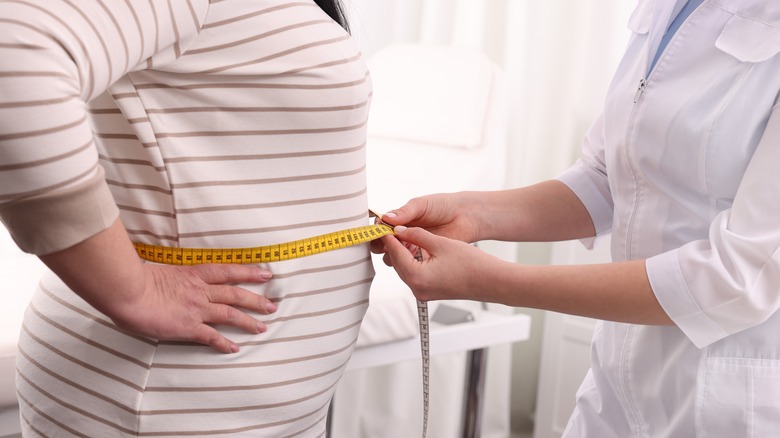Do This With Your Stomach At Least Once A Year To Check Your Risk Of Heart Disease
Heart disease is often called the "silent killer" because some people might not know they have heart disease until they experience a significant event like a heart attack. You're more likely to develop heart disease if your blood pressure is high, you have high cholesterol, or you smoke. The U.S. Centers for Disease Control and Prevention says that almost half of people have one of those conditions.
Yet other conditions and behaviors also put you at risk for heart disease, and some of them are related to other risk factors. Type 2 diabetes is often associated with high blood pressure. An unhealthy diet and lack of exercise are connected to high cholesterol. Obesity and heavy drinking also increase your risk of heart disease.
An annual trip to the doctor will take your blood pressure, and you'll also get your cholesterol checked depending on your age. And yes, you'll have to step on a scale and get a measure of your height to check your body mass index (BMI). Don't get offended when your doctor measures your waistline. Your waist circumference can tell you something about your risk of heart disease.
Waist circumference vs. BMI
The CDC classifies people as overweight if their BMI is over 25 and obese if it's over 30. According to a 2010 study in Obesity Research & Clinical Practice, men with a BMI over 30 are 80% more likely to develop coronary heart disease compared to men between 18.5 and 22.9. Women with a BMI over 30 are twice as likely. Waist circumference also says something about your risk of heart disease. Compared to men with a waist circumference of 33 inches or lower, men whose waist measures 40 inches or more are 2.25 times more likely to develop heart disease. Women with a waist measure of 34 inches or more have a 2.75 greater risk of heart disease.
People who have a lot of muscle carry more weight even if they have less body fat. That's why BMI is somewhat inadequate in predicting your health. However, how much weight you carry around your midsection might give an indication of visceral fat, which is more harmful to your overall health. Visceral fat is the fat around your organs, and you're less likely to see it like you do subcutaneous fat (fat under your skin).
Your BMI might be in a relatively healthy range, but your health could still be at risk. A 2008 study in the American Journal of Epidemiology found that people with a normal BMI and a large waist circumference had a 20% higher mortality risk compared to those with a normal waist circumference.
How to measure your waist circumference
The CDC says that a man could be at risk for obesity-related conditions such as heart disease if his waist circumference is 40 inches or more. Non-pregnant women are at risk if their waist measures more than 35 inches.
If you have a tape measure at home, you can check your waist circumference. Find your hip bones (i.e. the top of your pelvis) on each side. Wrap the measuring tape around your waist so that it's just above the hip bones. The tape shouldn't be too loose, but you also don't want the tape to press into your skin. You should be able to fit one finger inside the tape. Breathe out, then take the measurement.
If your waist circumference is above these limits, the National Institutes of Health says that just a 5% or 10% reduction in weight can lower your risk of obesity-related diseases. Because obesity is just one factor that can affect your health, you can make other changes in your lifestyle to decrease your risk of heart disease, such as getting plenty of exercise, eating a healthy diet, getting enough sleep, and managing stress and mental health. It's also a good idea to keep tabs on your blood pressure and cholesterol levels and quit smoking.



